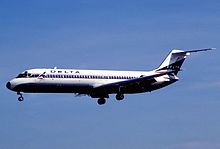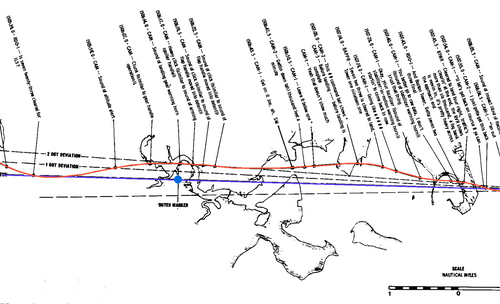Delta Air Lines Flight 723
 A Delta Air Lines McDonnell Douglas DC-9-30, similar to the one involved | |
| Accident | |
|---|---|
| Date | July 31, 1973 |
| Summary | Controlled flight into terrain due to pilot error and ATC error |
| Site | Logan International Airport Boston, Massachusetts, United States 42°20′59″N 071°00′45″W / 42.34972°N 71.01250°W |
| Aircraft | |
| Aircraft type | McDonnell Douglas DC-9-31 |
| Operator | Delta Air Lines |
| IATA flight No. | DL723 |
| ICAO flight No. | DAL723 |
| Call sign | DELTA 723 |
| Registration | N975NE |
| Flight origin | Burlington International Airport Burlington, Vermont |
| Stopover | Manchester-Boston Regional Airport Manchester, New Hampshire |
| Destination | Logan International Airport Boston, Massachusetts |
| Occupants | 89 |
| Passengers | 83 |
| Crew | 6 |
| Fatalities | 89 |
| Survivors | 0 |
Delta Air Lines Flight 723 was a flight operated by a McDonnell Douglas DC-9 twin-engine jetliner, operating as a scheduled domestic passenger flight from Burlington, Vermont, to Logan International Airport in Boston, Massachusetts, with an intermediate stop in Manchester, New Hampshire.[1] On July 31, 1973, at 11:08 a.m., while on an instrument landing system (ILS) instrument approach into Logan in low clouds and fog, the aircraft descended below the glidepath, struck a seawall, and crashed. All 89 of the occupants aboard were killed, including an initial survivor who died more than 4 months after the crash.[2]
Aircraft and crew
[edit]The DC-9-31, registration N975NE,[3] serial number 47075, was manufactured in September 1967 and had 14,639 flight hours at the time of the accident. The jetliner was one of the aircraft that Delta Air Lines acquired in their 1972 merger with Northeast Airlines, to whom the aircraft was originally delivered. The flight crew consisted of Captain John Streil (49) and First Officer Sidney Burrill (31). Captain Streil, a highly experienced pilot, had accumulated roughly 14,800 flight hours throughout his flying career. He had 17 years of experience as pilot-in-command and had been flying DC-9s since 1970, with 1,457 hours logged in them. First Officer Burrill was also an experienced airman, with just under 7,000 flight hours, including more than 200 hours on the DC-9. Occupying the cockpit jumpseat was a third pilot, Joseph Burrell (52), who was in training and was not yet qualified on the DC-9.[4]
Accident sequence
[edit]The aircraft, flying at 3,000 feet (910 m), had been vectored by Boston's approach control to intercept the final approach course to the ILS runway 4R approach at a 45-degree angle,[a] about 2 nautical miles (3.7 km; 2.3 mi) outside the outer marker.[4] As it was later revealed, the controller was busy handling a potential collision conflict between two other aircraft, and therefore neglected to clear Flight 723 for the approach. The flight crew had to ask the controller for approach clearance, which was immediately given, but by that time—more than a minute after the intercept vector had been issued—they were high and fast and almost over the outer marker. The flight crew subsequently failed to stabilize the aircraft's descent rate and airspeed, descended below the glideslope and drifted left of the localizer course, hitting a seawall about 165 feet (50 m) to the right of the extended runway centerline, about 3,000 feet (910 m) short of the runway's displaced threshold. The aircraft was destroyed and 87 of its 89 occupants were dead when rescuers arrived. One of the two initial survivors died after two hours, and the other was Leopold Chouinard, a 20-year-old sergeant in the U.S. Air Force, who died of burn injuries on December 11, 1973.[5][6] Chouinard is not listed by the National Transportation Safety Board (NTSB) as an official Delta 723 fatality due to requirements in the Code of Federal Regulations which, in 1973, defined a crash fatality as taking place within seven days of an accident.[7] The rule was subsequently changed in 2018, such that death must occur within 30 days of a crash.[8] Even under the revised rule, Chouinard would not be listed, as he died more than four months after the accident.
The weather conditions at the time of the crash were partial obscuration and fog, with a ceiling of 400 feet (120 m), one-half mile (0.80 km) visibility, and light winds. Runway visual range (RVR) was 1,400 to 6,000 feet (430 to 1,830 m).[4]
Investigation
[edit]The NTSB investigated the accident and was able to retrieve both the cockpit voice recorder (CVR) and flight data recorder (FDR). The investigators concluded that, based on the retrieved flight data and simulations, the flight crew very likely operated the flight director improperly, inadvertently switching it into a "go around" mode during the final approach, instead of the appropriate approach mode. This caused confusion and additional pressure, and contributed to the unstabilized approach and deviation from the glide path.[1] According to the CVR, no altitude callouts were made by the crew during the final approach, as the aircraft descended below the glideslope and decision height, until it struck the seawall and crashed.[4]
The board determined the following probable cause for the accident:
...the failure of the flightcrew to monitor altitude and to recognize passage of the aircraft through the approach decision height during an unstabilized precision approach conducted in rapidly changing meteorological conditions. The unstabilized nature of the approach was due initially to the aircraft's passing the outer marker above the glide slope at an excessive airspeed and thereafter compounded by the flightcrew's preoccupation with the questionable information presented by the flight director system. The poor positioning of the flight for the approach was in part the result of nonstandard air traffic control services.
See also
[edit]- Asiana Airlines Flight 214 – Struck a seawall after descending under the glidepath on landing
- Atlas Air Flight 3591 – An accident caused by inadvertently switching the aircraft into a go-around mode on approach
- China Airlines Flight 140 – An accident caused by inadvertently switching the aircraft into a go-around mode on final approach
- Air China Flight 129, Garuda Indonesia Flight 152, Air Inter Flight 148 and Dan Air Flight 1008 – Other CFIT accidents caused by ATC and pilot errors
- List of disasters in Massachusetts by death toll
Notes
[edit]- ^ According to the NTSB report, 30 degree is the normal recommended maximum ILS intercept angle near the outer marker.
References
[edit]![]() This article incorporates public domain material from websites or documents of the National Transportation Safety Board.
This article incorporates public domain material from websites or documents of the National Transportation Safety Board.
- ^ a b Ranter, Harro. "ASN accident record". aviation-safety.net. Aviation Safety Network. Retrieved July 14, 2009.
- ^ Burden, Leanne; Tuite, Lisa (August 1, 2012). "Flight 723: Boston's worst plane crash in history". The Boston Globe. Retrieved August 15, 2020.
- ^ "FAA Registry (N975NE)". Federal Aviation Administration.
- ^ a b c d "Aircraft Accident Report, Delta Air Lines, Inc., Douglas DC-9-31, N975NE, Boston, Massachusetts, July 31, 1973" (PDF). National Transportation Safety Board. March 7, 1974. NTSB-AAR-74-3. Retrieved June 21, 2019 – via Embry–Riddle Aeronautical University.
- ^ Bruzelius, Nils J. (December 12, 1973). "Lone crash survivor dies". The Boston Globe. p. 66. Retrieved July 29, 2023 – via newspapers.com.
- ^ "Struggle of Leopold Chouinard". CelebrateBoston.com.
- ^ 49 CFR 830.2
- ^ NTSB Form 6120.1. "Pilot/Operator Aircraft Accident/Incident Report" (PDF). US Government OMB. Retrieved December 17, 2018.
{{cite web}}: CS1 maint: numeric names: authors list (link)
Further reading
[edit]- Buell, Spencer (July 28, 2023). "Fifty years later, families reflect on Logan plane crash that killed 89 people". The Boston Globe. Retrieved July 29, 2023.
- Barry, Ellen (September 7, 2023). "The Orphans of Flight 723". The New York Times. Archived from the original on September 7, 2023. Retrieved September 7, 2023.
External links
[edit] Media related to Delta Air Lines Flight 723 at Wikimedia Commons
Media related to Delta Air Lines Flight 723 at Wikimedia Commons
- 1973 in Boston
- Accidents and incidents involving the McDonnell Douglas DC-9
- Airliner accidents and incidents in Massachusetts
- Airliner accidents and incidents involving controlled flight into terrain
- Airliner accidents and incidents caused by pilot error
- Aviation accidents and incidents in the United States in 1973
- Delta Air Lines accidents and incidents
- July 1973 events in the United States
- Logan International Airport
- Aviation accidents and incidents caused by air traffic controller error
- Disasters in Boston


